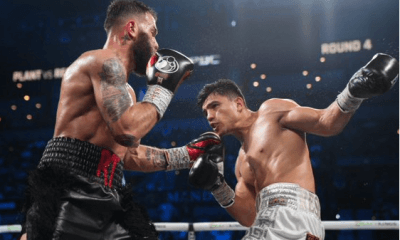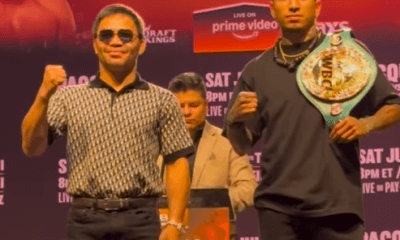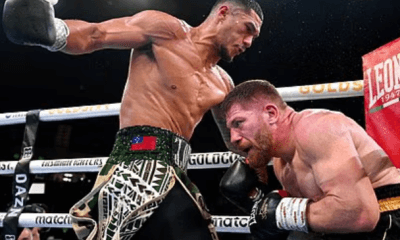Featured Articles
The Year in Boxing, Part 3
Tommy Morrison, a certified hammerfist with a compelling bio and Tiger Beat-level looks, left us too soon, this September. He was presented as a Caucasian sensation who could maybe take the Tyson baton but too much partying and a diagnosis of the presence of HIV in his system short-circuited his career. He left behind a solid body of work, though, and a rep as a damned-fine pugilist.
Here’s what I wrote upon his passing: Morrison used boxing to get distance from himself and a difficult home life, where his volatile dad could be abusive–dad put him in Toughman shows when he was in seventh grade–so it can be argued that Morrison is an example of boxing’s ability to lift up, as it gave him purpose and direction. He also helped convince holdouts that HIV isn’t a “gay” disease, that the virus can be spread by heterosexuals, so for that inadvertent public service, he can be commended.
The theater of the unexpected didn’t disappoint in September, with the news that the Golden Boy, Oscar De La Hoya, had succumbed to the perils of addiction again, and that he’d miss the Floyd Mayweather-Canelo Alvarez fight because he’d instead be entering rehab. This statement went out days before Floyd’s bout: Canelo Alvarez and I have big fights coming up this weekend. His is the ring and mine in treatment. I will not be at the fight to cheer Canelo to victory since I have voluntarily admitted myself into a treatment facility. I explained this to Canelo and he understood that my health and longterm recovery from my disease must come first. Thank you for your understanding. I ask for your support and privacy during this difficult time for me and my family. Oscar exited rehab in time to share the holidays with his family.
Mayweather on Sept. 14 made Alvarez look like the guy who didn’t win rounds against Matthew Hatton, Ryan Rhodes and Austin Trout as definitively as you’d want in order to give him much of a chance to beat the best boxer of his (and maybe others’) generation. Somebody named CJ Ross inserted herself into the narrative, when she hallucinated a 114-114 draw scorecard in Las Vegas, but luckily sobriety and the scorecards of Dave Moretti (116-112) and Craig Metcalf (117-111) over-rode Ross’ brown acid trip of idiocy. A couple days later, Ross slid herself under the bus, telling commission boss Keith Kizer, “I will be taking some time off from boxing but will keep in touch.”
Ken Norton died at age 70 on Sept. 18, his legacy best understood by true fight fans who knew he simply had Ali’s number, and probably deserved better than a 1-2 record against The Greatest.
Miguel Cotto turned back the clock on October 5, showing a brand of handspeed, body-snatching and aggression against Delvin Rodriguez that many assumed he’d left in the rear-view mirror. The Puerto Rican kept himself in the mix for megafights, out-landing the Friday Night Fights staple, 55-16, in a bit less than three rounds of target practice. Next for Cotto? “Line ’em up,” said the newest new trainer, Freddie Roach.
There was no shortage of takers who liked Juan Manuel Marquez to outsmart and strip down Timothy Bradley when they clashed fists on Oct. 12, especially after it became clear how messed up Bradley was from his violent carcrash against Ruslan Provodnikov. But Bradley boxed beautifully, playing all the angles just right and staying a step ahead of the vet Marquez, who looked like a regular 40-year-old rather than one who’d latched on to the services of a magical strength and conditioning coach. Glen Feldman’s garbage card for Marquez luckily was deemed irrelevant, but his poor eyesight shan’t go unremembered by me.
The following week saw another wickedly enjoyable rumble, for everyone but Mike Alvarado and team. Ruslan Provodnikov re-stamped himself into the hearts and minds of fight fans with his savagely stubborn effort in wresting the WBO 140 pound crown from Alvie at home in Colorado. The overseers, including ref Tony Weeks, drew props for their handling of the ending, which came after Alvie sat down following round ten. His body language screamed no mas, and Weeks pulled the plug. Weeks later, we’d be reminded what can happen when such signals aren’t paid attention to…
We hope that fight fans never forget the name Frankie Leal, a Mexican kid who gave, literally, his all in the ring. November will be remembered for an in-the-ring tragedy which leaves us holding out hope.
Russian heavyweight Magomed Abdusalamov on November 2 met Mike Perez on the Gennady Golovkin-Curtis Stevens undercard in NYC, and one heavyweight, each mans’ handlers told me, would leave the ring a star in the division. Little did we know one man would leave the ring with compromised health; Mago suffered brain damage, was rushed to an NYC hospital after losing a ten round decision, and today, is working to regain basic bodily abilities in an upstate rehab facility.
On Nov. 9 in Texas, Mikey Garcia kept up his momentum, with a win over Rocky Martinez, and Nonito Donaire restored a bit of luster with a win over Vic Darchinyan after taking on damage during a Rigolutionary war against the Cuban wizard Guillermo Rigondeaux. Last year, it was Donaire who was seen as an ascendent stud with Garcia still climbing the prospect to contender to champ rungs, again illustrating for us how fortune can shift like the mercury in the age of climate change.
The drama leading up to the Nov. 23 Manny Pacquiao-Brandon Rios fight wasn’t much present until Freddie Roach and former pal Alex Ariza stirred the pot. A few days before fightnight, Roach wanted Team Rios to exit the hotel gym, so Team Pacman could work out, and had words with trainer Robert Garcia and Ariza, who threw a karate kick at Roach when Dedham Freddie advanced on the former Pacman employee. Pacman’s offense in Macau was better than that offered by Ariza, as he had his way with an overmatched Rios, who showed more zest for combat after the fight, against the media, than he did versus the Congressman.
The exultation for Pacman, who dedicated the win to countrymen laid out by a horrific typhoon, was tempered slightly by tangles with tax collectors in the Philippines and the US, which are still being dealt with and negotiated at the time of writing.
The light heavyweight division reached a level of prominence unseen in a dog’s age, when Sergey Kovalev rolled over Ismayl Sillakh and Adonis Stevenson took apart Tony Bellew in Montreal Nov. 30. All expect them to do the obvious, and meet each other in a test of supremacy but this being boxing, only a fool believes that’s a given.
Showtime looked to end the year with a conclusive, concussive stamp, putting on back to back Golden Boy cards December 7 and Dec. 14.
Paul Malignaggi won the night in Brooklyn, showing that he had oodles more in the tank than ultra-desultory Zab Judah, enroute to a UD win in the Battle of Brooklyn.
The next week, Marcos Maidana stripped Adrien Broner naked in Texas, exposing the man who boasted he was About Billions, and the next logical star to inherit the Mayweather throne. No fighter had more people tuning in to see him lose than Broner, apart from Mayweather, and AB left the haters happy, losing a wide UD, while getting knocked to the mat twice.
The theater of the unexpected had one more showing, with cornerman Alex Ariza being accused of possibly giving fighter Maidana some sort of liquid or chemical aid during the bout, an allegation Ariza vigorously denied. Frame by frame examination of out of context video makes Ariza’s denials less sturdy, but Twitter is a place to brag about your gymflow and such, not a place to examine, process and litigate issues with much in the way of stringent standards and practices. But lordy, does it pass the time in entertaining fashion. Just like our sweet science does. It was a year of beauty and beastliness, the sublime and the sordid, a year in which we celebrated the best a man is capable of giving and the exorbitant price that is sometimes paid for entering a zone where only the hardiest of souls, people composed of a sturdier fiber than I, dare step.
-

 Featured Articles4 weeks ago
Featured Articles4 weeks agoA Night of Mismatches Turns Topsy-Turvy at Mandalay Bay; Resendiz Shocks Plant
-

 Featured Articles2 weeks ago
Featured Articles2 weeks agoAvila Perspective, Chap. 330: Matchroom in New York plus the Latest on Canelo-Crawford
-

 Featured Articles1 week ago
Featured Articles1 week agoVito Mielnicki Jr Whitewashes Kamil Gardzielik Before the Home Folks in Newark
-

 Featured Articles4 weeks ago
Featured Articles4 weeks agoRemembering the Under-Appreciated “Body Snatcher” Mike McCallum, a Consummate Pro
-

 Featured Articles4 weeks ago
Featured Articles4 weeks agoAvila Perspective, Chap 329: Pacquiao is Back, Fabio in England and More
-

 Featured Articles3 weeks ago
Featured Articles3 weeks agoOpetaia and Nakatani Crush Overmatched Foes, Capping Off a Wild Boxing Weekend
-

 Featured Articles3 weeks ago
Featured Articles3 weeks agoFabio Wardley Comes from Behind to KO Justis Huni
-

 Featured Articles2 weeks ago
Featured Articles2 weeks agoCatching Up with Clay Moyle Who Talks About His Massive Collection of Boxing Books
















